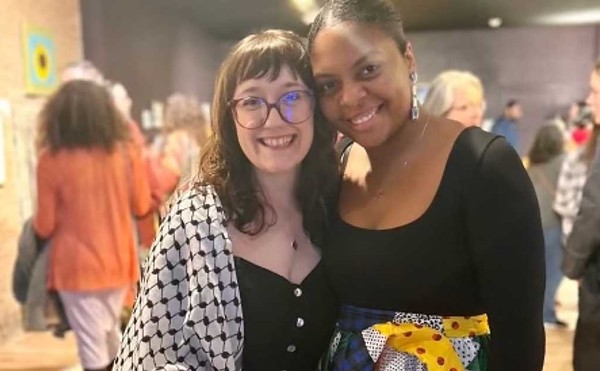Except for one monumental work of art, everything about the current exhibition at the Museum of Contemporary Art Detroit is seductively understated. Words Fail Me is the show's title, only insofar as it's a figure of speech exemplifying an elusive, far-reaching subject. More so, the title is itself a work of art, crying out.
The visiting curator for Words Fail Me is Matthew Higgs, director and chief curator of the alternative art space White Columns, a vigorously active and influential not-for-profit New York gallery. He's also an artist who began as a zinester, and his work modestly and wittily interrogates the slippage and frailty of words.
Higgs was fully aware of the liabilities of producing an exhibit with such seemingly modest artistic flair for Detroit. In freelancer Brian Sholis' recent interview with Higgs for Metro Times, Higgs says,
In New York someone who organizes an exhibition can rely on a certain bedrock experience, and, extending from that, a conditioned [aesthetic] response. We're so familiar with Jack Pierson's sculptures made of found signage that we've even seen them parodied in the Barney's shop window. One of the fascinating things about Detroit is that the work of many of these artists is being seen locally for the first time. It certainly changed how I view a lot of the work in the show, and some of the inclusions were influenced by my visits to the city, which looks very similar to the area in which I grew up in the north of England.
The curatorial cheat sheet (aka Higgs' "exhibition essay") that audiences flounder for in such conceptually based exhibits is here abbreviated, without elaborate explanations, leaving the viewer stuck with the lion's share of the work. Higgs' most useful statement is that the show "explores visual art's ongoing — and often uneasy — relationship with languages." The art then, sometimes beautiful, and always wonderfully arranged in MOCAD's echoing space, awaits prying eyes.
Upon entering the museum, visitors are confronted by four metal letters recycled from old signs, spelling out a word in flaking paint. Artist Jack Pierson offers a moment of truth and recognition. What do you see: Is it "Dead" or "de AD," like a French or Italian word for advertisement? Or maybe a hybrid of death and advertising? This opportunity to interrogate yourself about what you read can be alarming. Don't hurry past this piece. Higgs positioned it at the entrance for two reasons: to say that language is what you bring to it, and also to warn that, in a sense, language is dead, especially in art. It is our job, as viewers, to resuscitate it, to give words meaning by giving them context.
Walking around the wall on which Pierson's piece hangs, Higgs counters the conceptual with an installation of 81 expressive drawings by French-born artist Anne-lise Coste. On two huge walls, Coste's "Parmi les singes and les signes (tristesse et beauté)" (a partial English translation would be "being among monkeys and marks") are graffiti drawings that look like obsessive, subconscious doodles and phrases from a schoolgirl's diary.
I don't care, I don't have to think, I wanted to die for you
The young cursive merges and separates as if to say words and pictures are one and the same. But rather than crude doodles as they first may seem, the drawings are accomplished, multi-layered illusions of space, referencing art history by suggesting cubism and abstract expressionism. And equally, the words begin to sting with their candor.
In the same room, British artist Jeremy Deller, filmmaker, conceptual artist, political activist and winner of the 2004 Turner Prize, has piled three large stacks of broadsides, with text in English, Hebrew and Arabic. The posters co-opt lyrics from a Kinks song:
I was born, lucky me
in a land that I love
though I'm poor, I am free
when I grow I shall fight
for this land I shall die
let her sun never set
It's a contradictory statement on British imperialism that amounts to a suicidal anthem for everyone, if people of English, Arabic and Hebrew-speaking countries embrace its ideologies.
Nearby, in clear pushpins on a white wall, English artist Siobhan Liddell spells out "Weakness is strength." The barely-there construction is a manifestation of meaning and a Gandhian display of passive resistance.
Philippe Parreno and Rirkrit Tiravanija's video collaboration, "Stories are Propaganda," is replete with images: landscapes, a magic show and a rabbit in a mud puddle, all subverted by a poetic narrative delivered by the uncanny sweet voice of a child. It's worth repeated listening to hear the absurd account of why the world is as it is.
On a more conceptual level, Sam Durant's light box (selected from a larger series) reads "Let's Judge Ourselves as People," brilliantly recycling the politics of a women's rights demonstration. Durant's simplistic gesture, pulling a phrase off a handwritten placard and illuminating it in its original form, gives another saliently sad commentary, highlighting the ephemeral nature of memory.
Whether narratives, linguistic site-gags or verbal contradiction of logic, whether constructed of neon or paint, video or film, there are pieces here that some viewers will dispel as weak one-liners. But given enough time, this show provides significant insight into the way artists use words. As a whole, it points to a global failure of communication. There are famous, foreign and unknown artists, but what Higgs has fashioned is a global house of Babel, in which the very terms of language have been sussed, and determined a failure.
Words Fail Me runs though Jan. 20, at MOCAD, 4454 Woodward Ave., Detroit; 313-832-6622.





